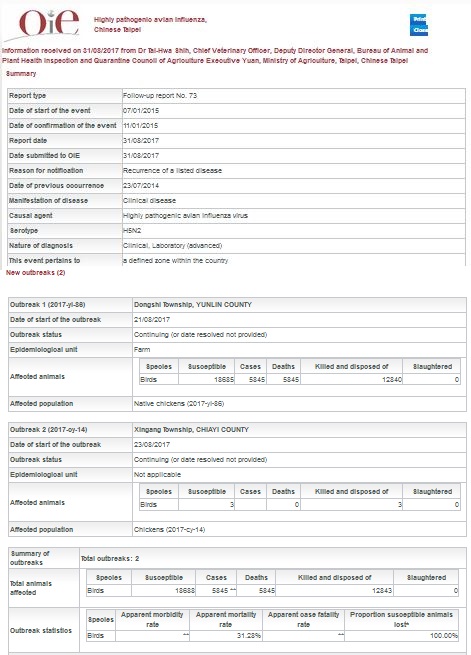#12,742
When H5N8 broke out of South Korea and jumped to North America in the Fall of 2014, it also hitched a ride on migratory birds south to the island nation of Taiwan, where it spun off several subtypes (H5N3, H5N2) and caused more than 1,000 poultry farm outbreaks in 2015.
Taiwan saw a significant reduction in their bird flu activity during 2016 - including very few cases last summer. By contrast, this year we've seen a slow but steady trickle of reports throughout the summer (see OIE reports list).The persistence of HPAI H5 in Taiwan since January of 2015 has led some to take drastic actions, including the illegal importation of Chinese poultry vaccines (see June 25th's Taiwan Seizes 210 Bottles of Illegal Chinese `Poultry Vaccine').
Over the weekend Focus Taiwan published New Taipei on high alert for H5 avian flu outbreaks, after a local slaughterhouse reported HPAI H5 infected birds on three of their nine slaughter lines. Today the OIE published an update, which details the discovery at the slaughterhouse, along with at least one infected farm in Yulin County.
Source of the outbreak(s) or origin of infection
Unknown or inconclusive
Epidemiological comments
Samples from one poultry farm in Yunlin County were sent to the National Laboratory, Animal Health Research Institute (AHRI) for analysis. Highly pathogenic avian influenza H5N2 subtype was confirmed by the AHRI. The farm has been placed under movement restriction. All animals on the infected farm have been culled.
Thorough cleaning and disinfection have been conducted after stamping out operation. Surrounding poultry farms within a 3 km radius of the infected farm are under intensified surveillance for three months.
Poultry carcasses were found during inspection in one illegal private abbatoir in Chiayi County. Samples were sent to the AHRI for diagnosis. H5N2 subtype HPAI was confirmed by the AHRI. The carcasses were destroyed and thorough cleaning and disinfection have been conducted in the abattoir. We have been attemping to trace back to the farm of origin. Any positive outcome will be included in the follow-up reports. Surrounding poultry farms within a 3 km radius of the infected farm are under intensified surveillance for three months.
Although it appears more an anecdotal observation than a scientific fact, there is open speculation in Taiwan's media today that the HPAI H5 virus may have adapted to warmer temperatures, which might explain a 4-fold increase in outbreaks this summer over last.
This translated report from UDN news.
Viruses adapt to high temperatures? This summer is now repeated bird flu
Xinbei City yesterday found H5 subtype of high pathogenic avian influenza virus cases; three slaughter line each have a chicken was found infected with avian flu, traceable inventory Taoyuan Bade, Yunlin water forest two chicken farms, one of the remaining chicks Destroyed, another mobile control. Agricultural Bureau of Defense Bureau yesterday has been confirmed to be H5N8, no evidence of missing birds.
Prevention and Control Bureau also alarm, avian flu has always occurred in the autumn and winter, this summer, there have been many cases, it is rare.
According to the statistics of the Bureau, the number of confirmed and culinary killings of high-disease poultry flu from July to September last year included only two goose farms and one poultry farm, but the poultry farms confirmed from July to August this year Twelve, four times last year; in early September there has been a case of diagnosis, but last year nine to eleven only one case of the epidemic.
Deputy Director of the Anti-Regime Bureau, said that the number of cases in the country this year is significantly higher than last year, the virus seems to have begun to adapt to high temperatures, leading to early cases.
(Continue . . . )
We've seen similar speculation regarding China's H7N9 virus, and of course we've seen unusual H5N8 activity this summer in Europe as well. None of which is conclusive, but all of which has poultry interests across the Northern Hemisphere gearing up for what could be another difficult bird flu winter ahead.

